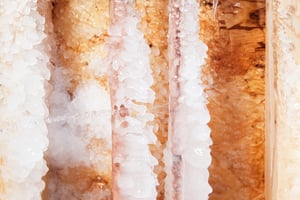 Have you ever come home to the sound of running water or wet floors? If so, you know this can cause a frantic situation. What you do next can make the problem better or worse.
Have you ever come home to the sound of running water or wet floors? If so, you know this can cause a frantic situation. What you do next can make the problem better or worse.
Extreme cold temperatures can cause the water in your pipes to freeze, leading to significant damage. Below are some things to watch for and tips for dealing with frozen pipes.
Frozen pipe warning signs
Before a pipe bursts due to freezing, there are some signs to watch for. Awareness can help prevent severe damage from occurring.
1. No running water.
Water plays a significant role in our daily lives. If you turn on the faucet for a glass of water or jump in the shower and no water comes out, you may have a problem. Another sign is significantly low water pressure.
2. The pipes are frosty.
There are pipes running in all different directions in your home, so it’s hard to see them all. However, keeping an eye on lines under your sink can help prevent damage. If they have frost on them, this is a tell-tale sign that you have a problem.
3. Unusual odors.
If you smell a foul or unusual odor from a faucet or drain, this may be another warning sign that your pipes are frozen.
4. Cold water.
If you turn on the hot water, but only cold water comes out, that’s also a sign that your pipes are frozen. If your pipes aren’t frozen, there may be a problem with your water heater.
What to do when a frozen pipe bursts
1. Find your main water supply shut-off valve.
No matter the problem, the key to stopping a water leak is to turn off the water to your entire home. To do this, you’ll need to find your shut-off valve. To help you find this more quickly, attaching a shut-off tag is a good idea. To get one for your home, click here.
2. Clean up the water right away.
If your home has standing water from a burst pipe, cleaning up the water as soon as possible can help prevent further damage. If water sits for an extended period, there’s a good chance for mold growth.
3. Remove your personal items.
Depending on where the water leak occurs, you may have to remove items from that area quickly. Prioritize what things to remove based on value or sentiment. While many items can be replaced, family heirlooms or pictures can’t.
4. Call your local plumber.
An experienced plumber is trained to find, fix, and replace burst pipes timely. This isn’t the time to try and do it yourself.
5. Call your local electrician.
Based on how your home is built, your circuit breaker box may be near water lines. If water damage happens, please call your local electrician to identify and assist in the repairs.
6. Contact your insurance agent.
While an insurance policy can provide coverage for this type of damage, it’s important to talk to your independent insurance agent to determine the type of coverage you’ve purchased.
Preventing your pipes from freezing
1. Drain your outdoor hose.
Always drain water from outdoor hoses when the weather starts to get cold. All hoses should be removed from water spigots.
2. Turn off your outdoor spigot’s shut-off valve.
While new homes may have freeze-resistant water spigots, it’s still a good idea to find the valve in your basement and turn it off. The lines should also be drained of any remaining water.
3. Add insulation.
If water pipes are in an unheated part of your basement or garage, consider adding insulation to prevent them from freezing.
4. Keep your heat on.
Never let your home get below 55 degrees Fahrenheit during the winter months. If you're leaving for an extended vacation, consider installing a monitoring system. This system will send you a warning if your home goes below a specified temperature. You can then respond by having your neighbor or a family member inspect your home.
5. Keep a stream of water running.
Running water does not freeze. Keep a trickle of water going in your furthest sink from the main valve; this will help keep the water throughout your lines from freezing.
6. Open cabinet doors.
Opening cupboard and vanity doors will allow more consistent heat to your water lines.
7. Install temperature and moisture sensors.
There are various sensor technology options available. Temperature sensors will alert you when the home falls below a specified temperature. Moisture sensors will alert you to a water leak, whether from a frozen water line or any other leak.
Do you have any suggestions or information you’d like to share? I’d love to hear from you. Please share them in the box below.
This article is intended for general educational and illustrative purposes only and should not be construed to communicate legal or professional advice. Further, this article is not an offer to sell insurance. Please consult with your licensed insurance agent for specific coverage details and your insurance eligibility. All policies are subject to the terms, conditions, limitations, definitions, and exclusions contained therein.





